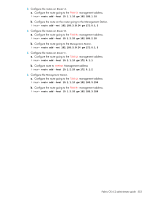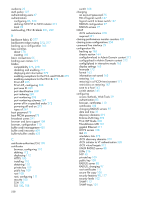HP StorageWorks 8/80 HP StorageWorks Fabric OS 6.2 administrator guide (5697-0 - Page 559
About Remote Switch, Remote Switch capabilities, Using Remote Switch with a gateway
 |
View all HP StorageWorks 8/80 manuals
Add to My Manuals
Save this manual to your list of manuals |
Page 559 highlights
F Using Remote Switch This appendix provides information on the Remote Switch feature. About Remote Switch The Remote Switch feature, which aids in ensuring gateway compatibility, was formerly a licensed feature. Its functionality is now available as part of the Fabric OS standard feature set through the use of the portCfgIslMode command, which is described in "Gateway links" on page 56. For those who use Remote Switch as part of their legacy set of tools, this appendix contains a description and procedure for the feature. Remote Switch enables you to connect two remote HP switches over an IP network, enabling communication of IP or ATM protocols as well as Fibre Channel traffic. The Remote Switch feature functions with the aid of a bridging device or Fibre Channel gateway. The gateway supports both a Fibre Channel physical interface and a secondary, non-Fibre Channel physical interface, such as IP, SONET, or ATM. Remote Switch functions over E_Port connections. With Remote Switch on both fabrics, the gateway accepts Fibre Channel frames from one fabric, tunnels them across the network, and passes them to the other fabric. From the viewpoint of the connected hosts and storage devices, fabrics using Remote Switch interact the same as locally connected switches. Remote Switch capabilities Remote Switch provides many of the same capabilities of normal ISL links including the following: • Coordinated fabric services: The Remote Switch fabric configuration fully supports all fabric services, including distributed name service, registered state change notification, and alias service. • Distributed management: Management tools such as Advanced Web Tools, Fabric OS, and SNMP are available from both the local switch and the remote switch. Switch management is routed through the Fibre Channel connection; thus, no additional network connection is required between sites. • Support for interswitch links (ISLs): Sites requiring redundant configurations can connect multiple E_Ports to remote sites by using multiple gateways. Standard Fabric OS routing facilities automatically maximize throughput and provide automatic failover during interruption on the WAN connection. Using Remote Switch with a gateway The Remote Switch feature operates in conjunction with a gateway. The gateway provides an E_Port interface that links to the HP StorageWorks switch E_Port. After the link between the two E_Ports has been negotiated, the gateway E_Port moves to passthrough mode and passes Fibre Channel traffic from the switch E_Port to the WAN. The gateway accepts Fibre Channel frames from one side of a Remote Switch fabric, transfers them across a WAN, and passes them to the other side of the Remote Switch fabric. Remote Switch can be used for the following types of gateway devices: • Fibre Channel over ATM • Fibre Channel over IP • Fibre Channel over SONET • Fibre Channel over DWDM Most of these gateway devices have enough buffers to cover data transfer over a wide area network (WAN). The Fabric OS switches on each side of the gateway must have identical configurations. Only qualified SFPs should be used. You must connect the fabrics through the gateway device, and make sure that the configure parameters are compatible with the gateway device. You may be required to reconfigure the following parameters, depending on the gateway requirements: Fabric OS 6.2 administrator guide 555















